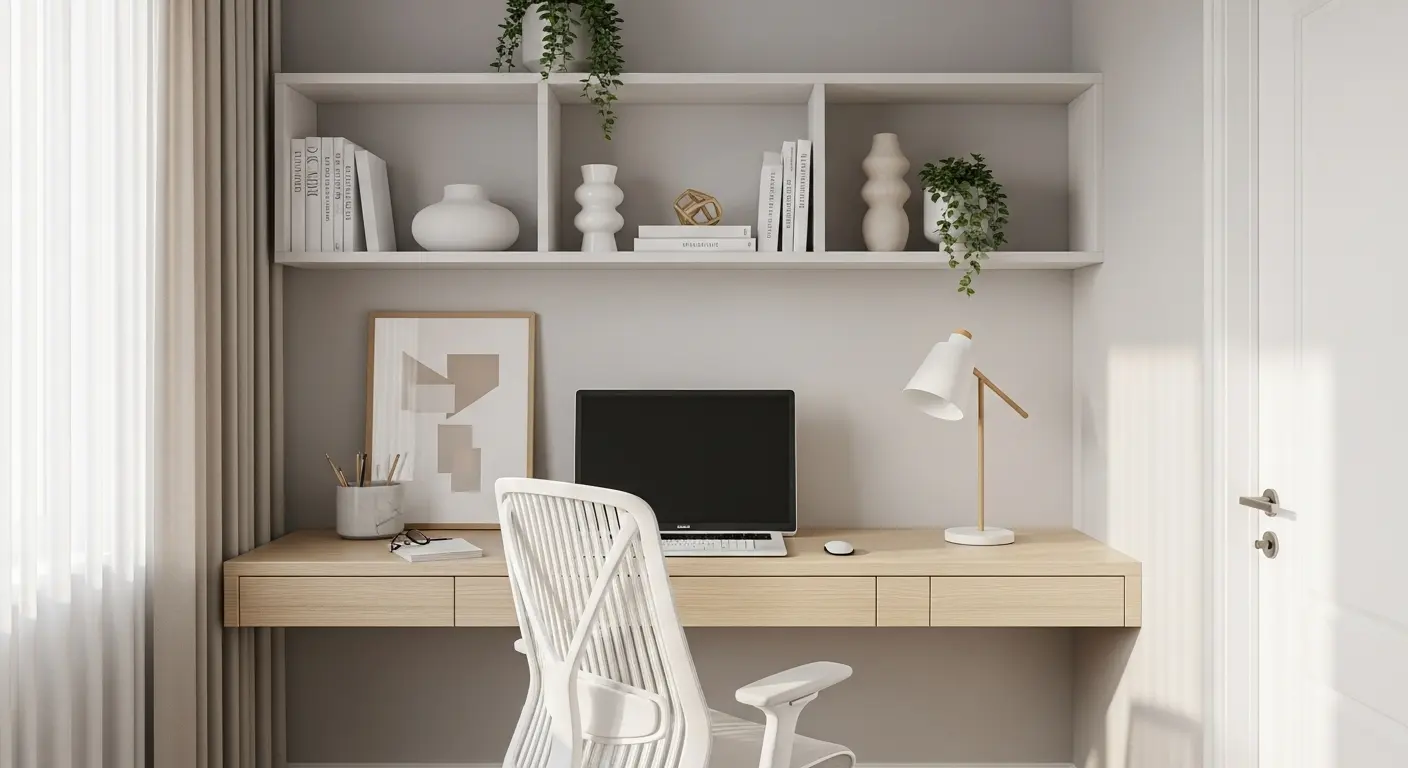
Setting up a minimalist home office in small spaces can seem impossible when the environment is already cluttered and full of distractions. Bulky chairs, huge desks, and cables everywhere not only take up space but also affect your productivity and well-being.
The good news is that with conscious and practical choices, you can turn even the smallest corner into a functional, light, and inspiring space.
In this article, you’ll discover how to create a minimalist home office in small spaces, with tips for choosing smart furniture, organizing without excess, and maintaining an environment that promotes focus and values the essential.
Why Minimalism Is Ideal for Small Home Offices
When it comes to working from home, especially in compact spaces, minimalism is more than an aesthetic trend: it’s a functional strategy that improves your productivity and well-being.
Benefits of minimalism for focus and productivity
An environment full of objects, bright colors, and visual stimuli can be tiring and easily distracting. In contrast, a minimalist space helps reduce mental overload and increases concentration.
Organized environments with few elements make decision-making easier, help keep the mind clear, and encourage creativity.
How it helps save space and reduce distractions
With less furniture and unnecessary objects, you can make better use of every available inch. Minimalism prioritizes compact furniture, vertical solutions, and clear surfaces, which makes the environment more functional and comfortable to work in.
This type of organization also avoids constant distractions from clutter or the need to reorganize the space every week.
Psychological impact of “less is more” at work
Minimalism provides a sense of lightness and tranquility. Working in a clear, clean, and well-planned space conveys the idea that everything is under control, reducing anxiety and increasing the sense of well-being during the workday.
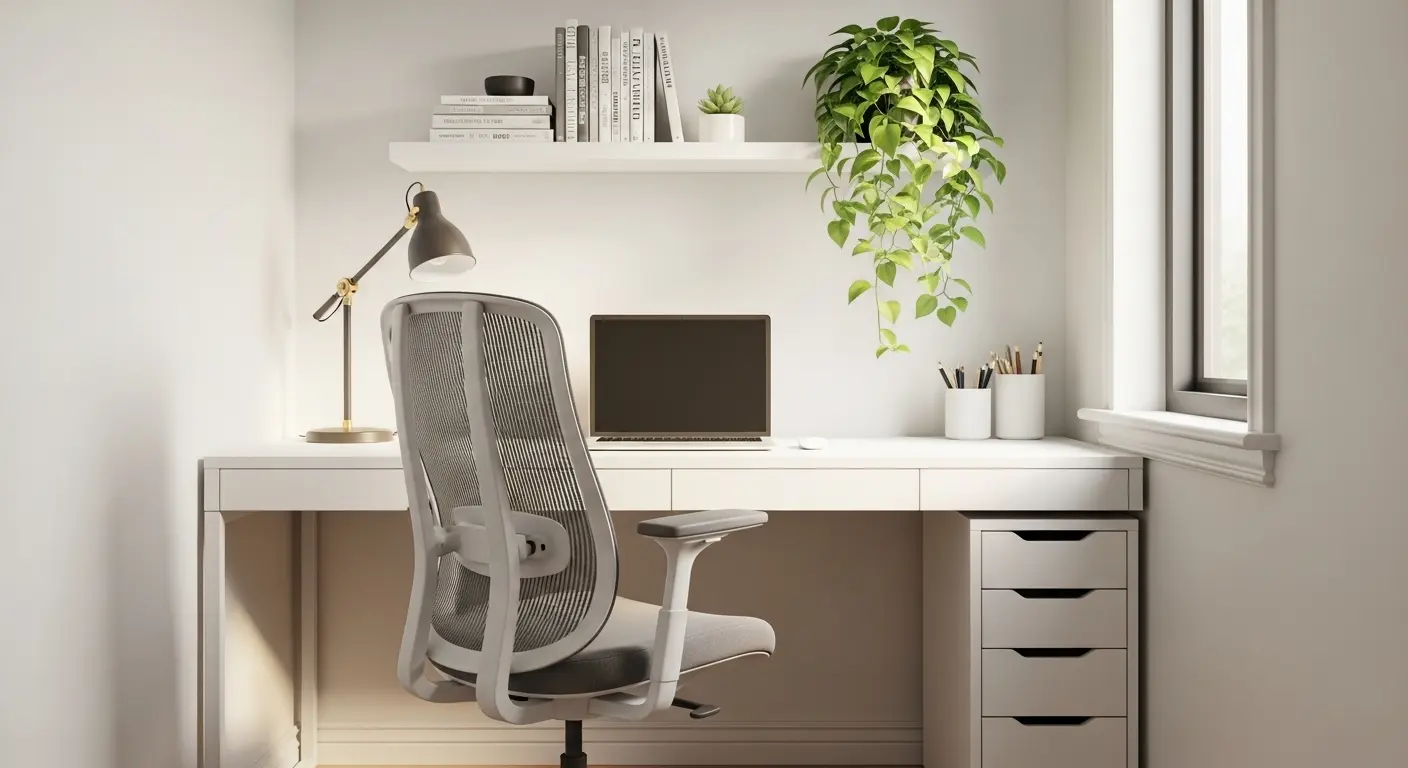
Assess Your Space and Define Its Function
Before you start setting up your minimalist home office in small spaces, it’s essential to carefully evaluate the environment and define exactly how it will be used. This initial planning helps avoid unnecessary purchases and ensures that the final result is functional and comfortable.
How to map out and choose the best corner to work
Observe your home and identify a quiet place with good ventilation and, if possible, natural lighting. It could be a corner of the living room, a space in the bedroom, or even a wide hallway. Measure the available space to know what furniture will fit without compromising circulation.
Also, check for outlets, internet signal, and whether the space offers some privacy for meetings and video calls.
Natural lighting and room acoustics
If possible, position your desk near a window to take advantage of natural light, which improves mood and productivity. If this is not feasible, supplement with directional lamps and choose a corner that is quieter and has less foot traffic.
In very small apartments, rugs, light curtains, and acoustic panels can help reduce noise and improve concentration.
How to define the workspace in integrated environments
When the home office shares space with other environments, such as the living room, it’s important to visually define this area. A rug under the desk, an open-shelf bookcase, or even a different paint color on the wall behind the desk helps mark the territory without the need for walls or heavy partitions.
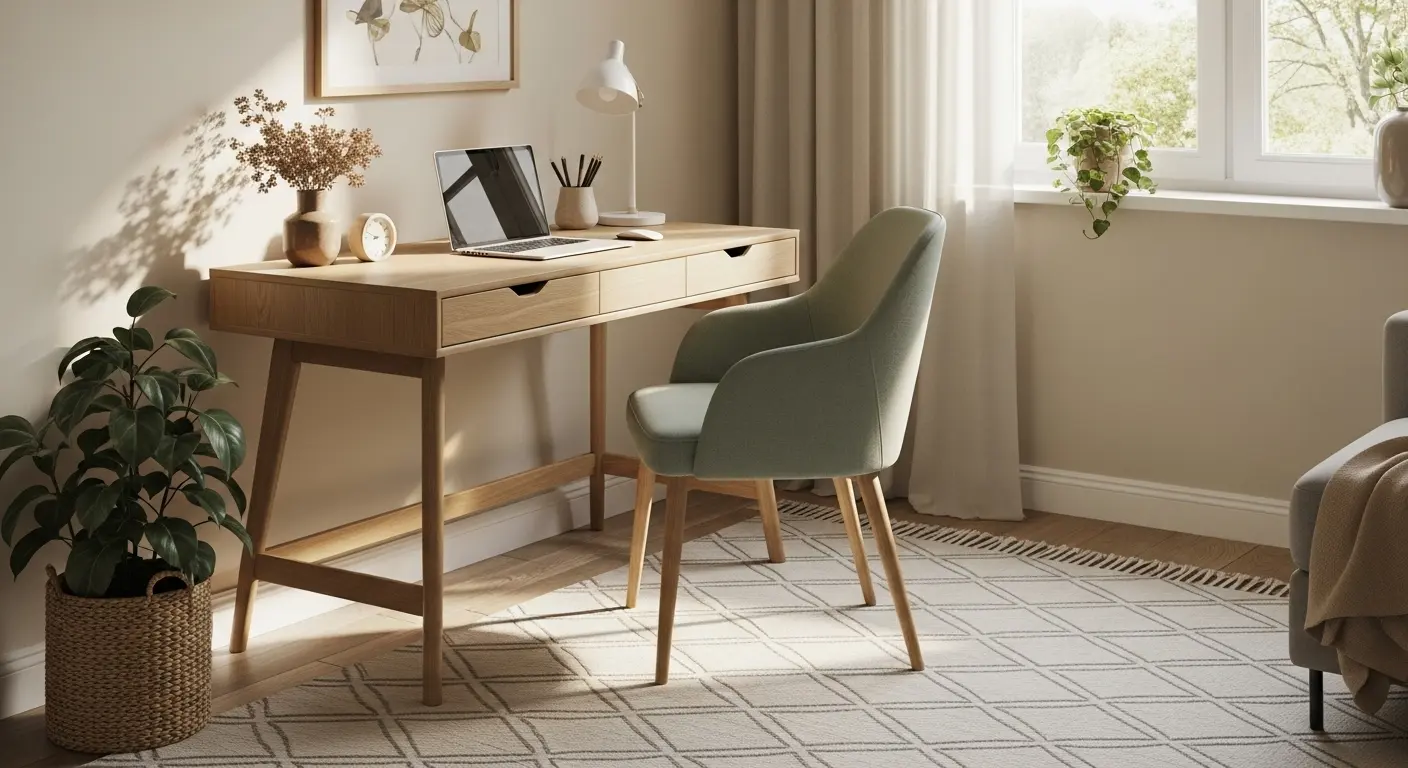
Choose Compact and Multifunctional Furniture
One of the pillars of creating a minimalist home office in small spaces is selecting furniture that optimizes every inch of the environment without compromising comfort or aesthetics.
Folding or retractable desks
For very limited spaces, wall-mounted folding or retractable desks are excellent alternatives. They can be opened only when in use and folded away in seconds, freeing up space for other activities.
Another option is narrow and long desks, which take up little space but still offer a good work area.
Ergonomic and lightweight chairs
The ideal chair for a small home office should be ergonomic to ensure postural health, but also lightweight and compact. Prefer models with a mesh back or straight lines, which take up less space and are easier to move.
If possible, choose a chair with a design that matches the decor so that it doesn’t clash with the rest of the environment.
Shelves and vertical solutions
Instead of bulky floor-standing drawer units, use vertical space with open shelves, niches, or wall-mounted cabinets. This strategy not only frees up circulation space but also helps keep everything organized and visually light.
For more ideas on space-saving furniture, also see: Multifunctional Furniture: The Ideal Solution for Small Apartments
Minimalist Organization: Fewer Items, More Concentration
After setting up the structure of your minimalist home office in small spaces, it’s the organization that keeps everything running smoothly. The fewer unnecessary items you accumulate, the easier it will be to work with focus and keep the space pleasant.
Techniques to avoid daily clutter
Adopt the “one in, one out” rule: for every new object or material that enters the home office, evaluate what can be removed.
Keep only the items you use every day on your desk—such as your computer, a notebook, and a pen. Store everything else in boxes, niches, or drawers.
Also include a “transition basket” to store documents or objects that still need to be organized without them being scattered around the space.
Smart storage solutions
Use drawer organizers, discreet boxes, and paper trays. Take advantage of vertical space with shelves and niches, leaving the floor free and the environment lighter.
Remember: everything should have a specific place. This prevents objects from being scattered and makes it easier to put them away after work.
How to keep surfaces clear and uncluttered
Clean surfaces contribute to a sense of order and help with concentration. Before ending the day, take a few minutes to put away items that are out of place and clean the desk.
This small daily ritual reinforces minimalism and prepares the environment for the next day.
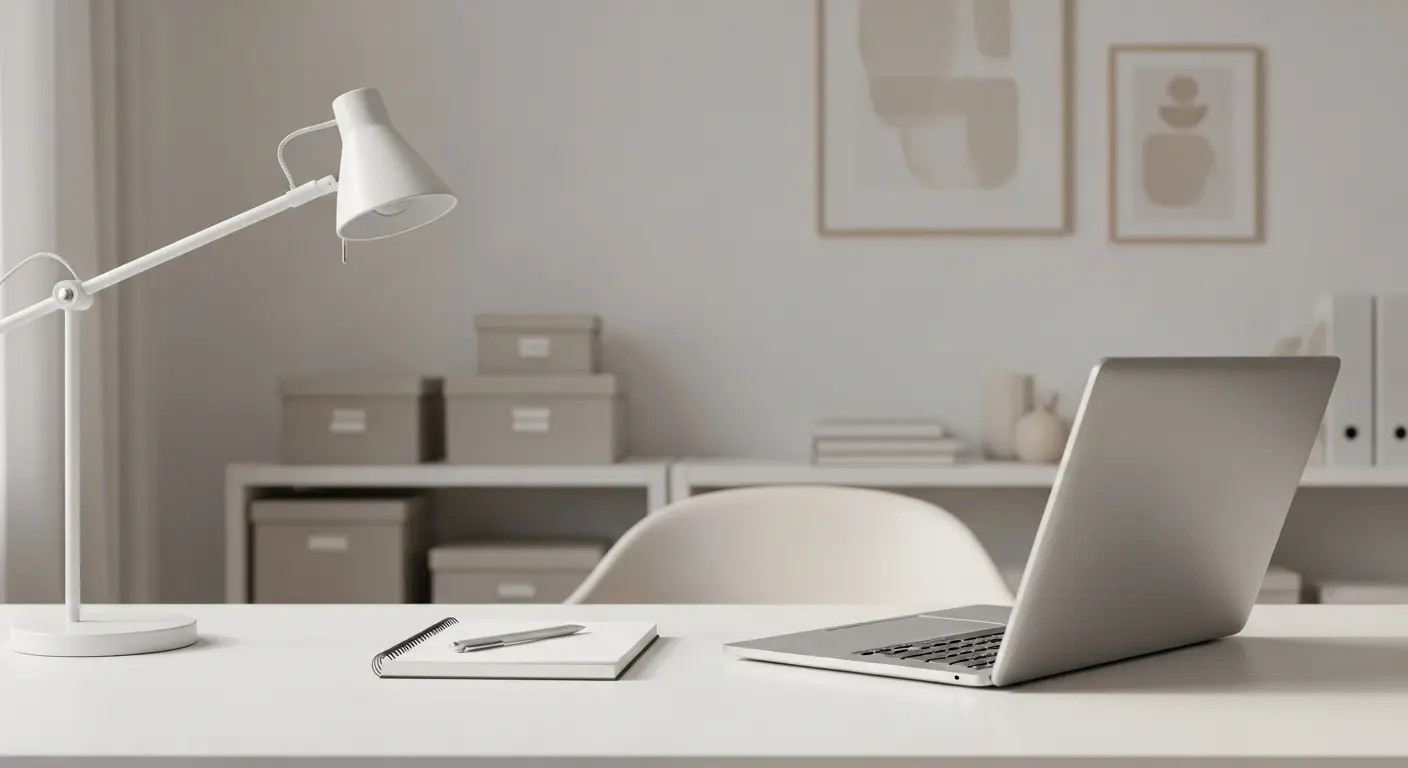
Stylish Touches Without Visual Clutter
A minimalist home office in small spaces doesn’t have to be boring. With the right choices, it’s possible to add personality and coziness without compromising the lightness and functionality of the environment.
Discreet plants to bring life to the space
Plants are great for adding freshness and a natural feel to the home office. Opt for small, easy-to-care-for species like the ZZ plant, pothos, or succulents. They take up little space and also help improve air quality.
You can place them on shelves, in the corner of the desk, or on the floor in neutral pots.
Functional accessories that also decorate
Choose a few objects that have a function and also serve as decoration. For example:
- Lamps with a clean design.
- An elegant pen holder.
- Trays to organize documents or cables.
These elements reinforce the minimalist aesthetic without creating visual noise.
Color palette and textures that inspire calm
In addition to neutral tones as a base—such as white, beige, and light gray—you can add small pops of color to give it identity. A picture with subtle art, a rug in an earthy tone, or a cushion in olive green bring balance to the look without being overwhelming.
For more inspiration on how to use colors and textures, also check out: Textures and Materials in Minimalist Design That Bring Visual Comfort
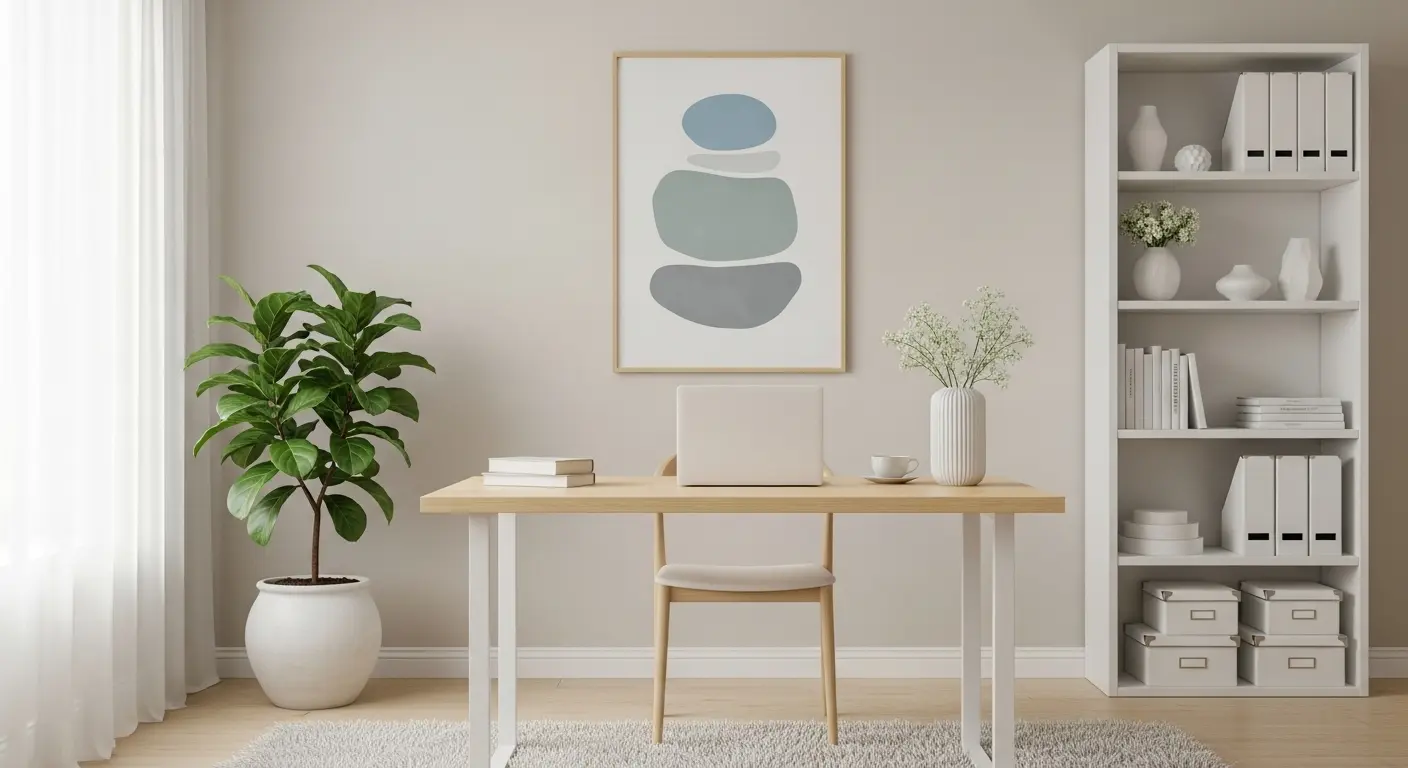
How to Keep the Space Functional Over Time
Setting up a minimalist home office in small spaces is just the beginning. For it to remain efficient and pleasant, it’s important to take care of daily maintenance and make small adjustments as your routine evolves.
Weekly organization habits
Set aside a moment at the end of each week to review what is out of place, clean the desk, and discard unnecessary papers. This practice prevents the space from becoming cluttered again and ensures that you start each week in a light and organized environment.
Maintaining an “inbox” for documents or items that need attention helps prevent clutter on the desk.
When and how to review items and materials
Periodically—for example, every season or every six months—do a deeper review. See if all items still have a function or if they are just taking up space.
Donate or discard materials you no longer use and, if necessary, replace furniture or accessories with more suitable versions.
How to adapt the space as your routine evolves
Over time, your needs may change. Perhaps you need a second monitor for work, or prefer to switch your chair for a more ergonomic model. The important thing is that the home office continues to meet your demands without losing its lightness and functionality.
Small periodic adjustments ensure that it remains practical, comfortable, and aligned with minimalism.
Comparative Table: Traditional vs. Minimalist Solutions for Small Home Offices
To better understand how minimalism transforms the workspace, check out this comparison between a traditional and a minimalist home office in small spaces:
| Item | Traditional Solution | Minimalist Alternative |
|---|---|---|
| Desk | Large, bulky desk | Folding or retractable desk, light and functional |
| Chair | Voluminous upholstered | Ergonomic, compact, and straight-lined |
| Storage | Heavy floor-standing drawers | Vertical niches and shelves |
| Decoration | Many objects and strong colors | Few meaningful elements and neutral tones |
| Lighting | Single central chandelier | Directed lamp + natural light |
This table shows that choosing minimalist solutions not only frees up physical space but also improves the aesthetics and functionality of the environment.
Conclusion: A Small Home Office Can Be a Great Ally in Your Routine
Creating a minimalist home office in small spaces proves that size doesn’t define functionality or style. With planning, conscious choices, and attention to detail, any corner of your home can transform into a light, productive, and welcoming environment.
By investing in multifunctional furniture, organizing with intention, keeping surfaces clear, and including only elements that have purpose, you not only optimize space but also improve your concentration and well-being during work.
Remember: less is more. You don’t need to fill the space to make it beautiful or comfortable. It’s quite the opposite—the more you prioritize the essential, the calmer and more functional it becomes.
How about taking the first step today? Choose a corner, sketch out what you need, and start eliminating what doesn’t serve you. You’ll be surprised by the impact a minimalist home office can have on your routine.
